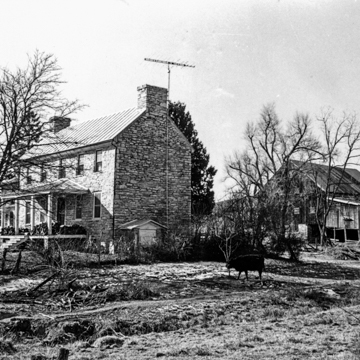You are here
Clover Mount (Stonehouse Farm)
This limestone residence of prosperous Scots-Irish farmer Robert Tate and his wife, Margaret, illustrates one of the first waves of permanent and substantial house building in Augusta County. It began as a two-story hall-parlor dwelling—a typical local plan in the eighteenth century, especially for log houses—at the right end of the existing structure. By 1803, Tate had enlarged the house to resemble the two-story center-passage houses that had begun to penetrate the Valley by the early nineteenth century. The one-room two-story addition on the left side of the original house features a corner fireplace, a common element of large houses in the county from this period. Rough stone jack arches surmount the first-story windows, and the entrance is sheltered by a later three-bay one-story wooden porch. The house retains some of the best surviving and most extensive examples of stenciled wall designs in the Valley, with vertical bands of geometric and flower designs in dark-green and iron-red colors in seven rooms. A large bank barn is behind the house.
Writing Credits
If SAH Archipedia has been useful to you, please consider supporting it.
SAH Archipedia tells the story of the United States through its buildings, landscapes, and cities. This freely available resource empowers the public with authoritative knowledge that deepens their understanding and appreciation of the built environment. But the Society of Architectural Historians, which created SAH Archipedia with University of Virginia Press, needs your support to maintain the high-caliber research, writing, photography, cartography, editing, design, and programming that make SAH Archipedia a trusted online resource available to all who value the history of place, heritage tourism, and learning.




















